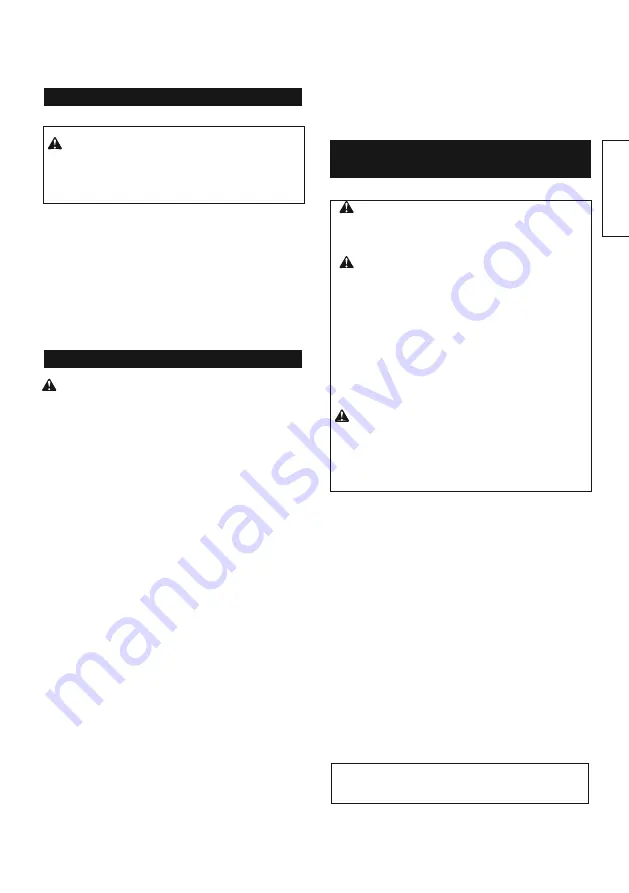
15 ENGLISH
Rip fence (Guide rule)
Optional accessory
CAUTION:
Make sure that the rip fence is
securely installed in the correct position before
use.
Improper attachment may
cause
dangerous kickback.
►
Fig.19:
1.
Rip fence (Guide rule)
2.
Clamping screw
The
handy
rip
fence
allows
you
to
do
extra-
accurate straight
cuts.
Simply
slide
the
rip
fence
up
snugly
against the side of the
workpiece and secure it in position with the clamping
screw on the front of the base. It also makes repeated
cuts of uniform width possible.
Lanyard (tether strap) connection
Safety warnings specific for use at height
Read all safety warnings and instructions.
Failure to follow
the
warnings and
instructions
may
result
in
serious
injury.
1.
Always keep the tool tethered when working
"at height". Maximum lanyard length is 2 m
(6.5 ft).
2.
Use only with lanyards appropriate for this
tool type and rated for at least 4.0 kg (8.8 lbs).
3.
Do not anchor the tool lanyard to anything on
your body or on movable components.
Anchor the tool lanyard to a rigid structure
that can withstand the forces of a dropped
tool.
4.
Make sure the lanyard is properly secured at
each end prior to use.
5.
Inspect the tool and lanyard before each use
for damage and proper function (including
fabric and stitching). Do not use if damaged
or not functioning properly.
6.
Do not wrap lanyards around or allow them to
come in contact with sharp or rough edges.
7.
Fasten the other end of the lanyard outside
the working area so that a falling tool is held
securely.
8.
Attach the lanyard so that the tool will move
away from the operator if it falls.
Dropped tools
will
swing
on
the
lanyard,
which
could
cause
injury
or loss of balance.
9.
Do not use near moving parts or running
machinery.
Failure
to
do
so
may
result
in
a
crush
or
entanglement
hazard.
10.
Do not carry the tool by the attachment
device or the lanyard.
11.
Only transfer the tool between your hands
while you are properly balanced.
12.
Do not attach lanyards to the tool in a way
that keeps guards, switches or lock-offs from
operating properly.
13.
Avoid getting tangled in the lanyard.
14.
Keep lanyard away from the cutting area of
the tool.
15.
Use multi-action and screw gate type
carabineers. Do not use single action spring
clip carabineers.
16.
In the event the tool is dropped, it must be
tagged and removed from service, and should
be inspected by a Makita Factory or
Authorized Service Center.
►
Fig.20:
1.
Hole
for
lanyard
(tether
strap)
NOTICE:
Never use gasoline, benzine, thinner,
alcohol or the like. Discoloration, deformation or
cracks may result.
MAINTENANCE
NOTE:
Some
items
in
the
list
may
be
included
in
the
tool
package
as
standard
accessories.
They
may
differ
from
country
to
country.
CAUTION:
Always be sure that the tool is
switched off and the battery cartridge is removed
before attempting to perform inspection or
maintenance.
CAUTION:
Clean out the upper and lower
guards to ensure there is no accumulated metal
chips which may impede the operation of the
lower guarding system.
A
dirty
guarding system
may
limit
the
proper
operation which
could
result
in
serious
personal
injury.
When using
compressed air to blow metal chips out of the
guards, wear a proper eye and breathing
protection.
CAUTION:
After each use, clean up the inside
of the dust box and wipe off the saw dust on the
tool.
Fine
metallic
dust
may
come
inside
the
tool
and
cause
malfunction
or
a
fire.
Summary of Contents for DCS553
Page 1: ......
Page 2: ...2 ...
Page 3: ...3 Fig 11 ...
Page 4: ...4 Fig 15 Fig 16 4 5 ...
Page 5: ...5 Fig 20 ...
Page 136: ...885652A993 ...
Page 137: ...Anjo Aichi 446 8502 Japan www makita com EN FR DE IT NL ES PT DA EL TR 20180323 ...
















































